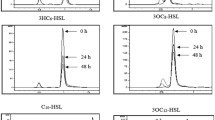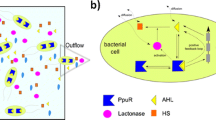Abstract
Some members of the moderately halophilic genus Halomonas, such as H. eurihalina, H. maura, H. ventosae and H. anticariensis, produce exopolysaccharides with applications in many industrial fields. We report here that these four species also produce autoinducer molecules that are involved in the cell-to-cell signaling process known as quorum sensing. By using the N-acyl homoserine lactone (AHL) indicator strains Agrobacterium tumefaciens NTL4 (pZRL4) and Chromobacterium violaceum CV026, we discovered that all the Halomonas strains examined synthesize detectable AHL signal molecules. The synthesis of these compounds was growth-phase dependent and maximal activity was reached during the late exponential to stationary phases. One of these AHLs seems to be synthesized only in the stationary phase. Some of the AHLs produced by H. anticariens FP35T were identified by gas chromatography/mass spectrometry and electrospray ionization tandem mass spectrometry as N-butanoyl homoserine lactone (C4-HL), N-hexanoyl homoserine lactone (C6-HL), N-octanoyl homoserine lactone (C8-HL) and N-dodecanoyl homoserine lactone (C12-HL). This study suggests that quorum sensing may also play an important role in extreme environments.



Similar content being viewed by others
References
Arias S, del Moral A, Ferrer MR, Tallon R, Quesada E, Béjar V (2003) Mauran, an exopolysaccharide produced by the halophilic bacterium Halomonas maura, with a novel composition and interesting properties for biotechnology. Extremophiles 7:319–326
Beck Von Bodman S, Majerczak DR, Coplin DL (1998) A negative regulator mediates quorum-sensing control of exopolysaccharide production in Pantoea stewartii subsp. stewartii. Proc Natl Acad Sci USA 95:7687–7692
Beck Von Bodman S, Bauer WD, Coplin DL (2003) Quorum sensing in plant-pathogenic bacteria. Annu Rev Phytopathol 41:455–482
Béjar V, Llamas I, Calvo C, Quesada E (1998) Characterization of exopolysaccharides produced by 19 halophilic strains included in the species Halomonas eurihalina. J Biotechnol 61:135–141
Bouchotroch S, Quesada E, del Moral A, Béjar V (1999) Taxonomic study of exopolysaccharide-producing moderately halophilic bacteria isolated from hypersaline environments in Morocco. Syst Appl Microbiol 22: 412–419
Bouchotroch S, Quesada E, Izquierdo I, Rodríguez M, Béjar V (2000) Bacterial exopolysaccharides produced by new discovered bacteria belonging to the genus Halomonas isolated from hypersaline habitats in Morocco. J Ind Microbiol Biotechnol 24:374–378
Bouchotroch S, Quesada E, del Moral A, Llamas I, and Béjar V (2001) Halomonas maura sp. nov., a novel moderately halophilic, exopolysaccharide-producing bacterium. Int J Syst Evol Microbiol 51:1625–1632
Cha C, Gao P, Chen YC, Shaw PD, Farrand SK (1998) Production of acyl-homoserine lactone quorum-sensing signals by Gram-negative plant-associated bacteria. Mol Plant Microbe Interact 11:1119–1129
Davies DG, Parsek MR, Pearson JP, Iglewski BH, Costerton JW, Greenberg EP (1998) The involvement of cell-to-cell signals in the development of a bacterial biofilm. Science 280:295–298
Dobson SJ, Franzmann PD (1996) Unification of the genera Deleya (Bauman et al., 1993), Halomonas (Vreeland et al., 1980), and Halovibrio (Frendrich et al. 1988) and the species Paracoccus halodenitrificans (Robinson and Gibbons, 1952) into a single genus Halomonas, and placement of the genus Zymobacter in the family Halomonadaceae. Int J Syst Bacteriol 46:550–558
Eberhard A, Longin T, Widrig CA, Stranick SJ (1991) Synthesis of the lux gene autoinducer in Vibrio fischeri is positively autoregulated. Arch Microbiol 155:294–297
Engebrecht J, Nealson K, Silverman M (1983) Bacterial bioluminescence: isolation and genetic analysis of functions from Vibrio fischeri. Cell 32:773–781
Engebrecht J, Silverman M (1984) Identification of genes and gene products necessary for bacterial bioluminescence. Proc Natl Acad Sci USA 81:4154–4158
Farrand SK (1998) Conjugation in Rhizobiaceae. In: Spaink HP, Kondorosi A, Hooykaas PJJ (eds) The Rhizobiaceae, Molecular Biology of Model Plant-Associated Bacteria. Kluwer, Dordrecht, pp 199–233
Fuqua WC, Winans SC, Greenberg EP (1994) Quorum sensing in bacteria: the LuxR-LuxI family of cell density-responsive transcriptional regulators. J Bacteriol 176:269–275
Fuqua C, Burbea M, Winans SC (1995) Activity of the Agrobacterium Ti plasmid conjugal transfer regulator TraR is inhibited by the product of the traM gene. J Bacteriol 177:1367–1373
Fuqua C, Parsek MR, Greenberg EP (2001) Regulation of gene expression by cell-to-cell communication: acyl-homoserine lactone quorum sensing. Annu Rev Genet 35:439–468
González JE, Marketon MM (2003) Quorum sensing in nitrogen-fixing rhizobia. Microbiol Mol Biol Rev 67:574–592
Gram L, Grossart HP, Schlingloff A, Kiorboe T (2002) Possible quorum sensing in marine snow bacteria: production of acylated homoserine lactones by Roseobacter strains isolated from marine snow. Appl Environ Microbiol 68:4111–4116
Holden MT, Ram Chhabra S, de Nys R, Stead P, Bainton NJ, Hill PJ, Manefield M, Kumar N, Labatte M, England D, Rice S, Givskov M, Salmond GP, Stewart GS, Bycroft BW, Kjelleberg S, Williams P (1999) Quorum-sensing cross talk: isolation and chemical characterization of cyclic dipeptides from Pseudomonas aeruginosa and other Gram-negative bacteria. Mol Microbiol 33:1254–1266
Hwang I, Cook DM, Farrand SK (1995) A new regulatory element modulates homoserine lactone-mediated autoinduction of Ti plasmid conjugal transfer. J Bacteriol 177:449–458
Johnson MR, Montero CI, Conners SB, Shockley KR, Bridger SL, Kelly RM (2005) Population density-dependent regulation of exopolysaccharide formation in the hyperthermophilic bacterium Thermotoga maritima. Mol Microbiol 55:664–674
Kaplan HB, Greenberg EP (1985) Diffusion of autoinducer is involved in regulation of the Vibrio fischeri luminescence system. J Bacteriol 163:1210–1214
de Kievit TR, Iglewski BH (2000) Bacterial quorum sensing in pathogenic relationships. Infect Immun 68:4839–4849
Kleerebezem M, Quadri LE, Kuipers OP, de Vos WM (1997) Quorum sensing by peptide pheromones and two-component signal-transduction systems in Gram-positive bacteria. Mol Microbiol 24:895–904
Kushner DJ, Kamekura M. (1988) Physiology of halophilic eubacteria. In: Rodríguez-Valera F (ed) Halophilic bacteria, vol 1. CRC, Boca Raton, pp 109–138
Luo ZQ, Clemente TE, Farrand SK (2001) Construction of a derivative of Agrobacterium tumefaciens C58 that does not mutate to tetracycline resistance. Mol Plant Microbe Interact 14:98–103
Lupp C, Urbanowski M, Greenberg EP, Ruby EG (2003) The Vibrio fischeri quorum-sensing systems ain and lux sequentially induce luminescence gene expression and are important for persistence in the squid host. Mol Microbiol 50:319–331
Marketon MM, Gronquist MR, Eberhard A, González JE (2002) Characterization of the Sinorhizobium melilotisinR/ sinI locus and the production of novel N-acyl homoserine lactones. J Bacteriol 184:5686–5695
Marketon MM, Glenn SA, Eberhard A, González JE (2003) Quorum sensing controls exopolysaccharide production in Sinorhizobium meliloti. J Bacteriol 185:325–331
Martínez-Cánovas MJ, Béjar V, Martínez-Checa F, Quesada E (2004a) Halomonas anticariensis sp. nov., from Fuente de Piedra, a saline-wetland, wildfowl reserve in Málaga, Southern Spain. Int J Syst Evol Microbiol 54:1329–1332
Martínez-Cánovas MJ, Quesada E, Llamas I, Béjar V (2004b) Halomonas ventosae sp. nov., a moderately halophilic, denitrifying, exopolysaccharide-producing bacterium. Int J Syst Evol Microbiol 54:733–737
Mata JA, Martínez-Cánovas J, Quesada E, Béjar V (2002) A detailed phenotypic characterization of the type strains of Halomonas species. Syst Appl Microbiol 25:360–375
McClean KH, Winson MK, Fish L, Taylor A, Chhabra SR, Camara M, Daykin M, Lamb JH, Swift S, Bycroft BW, Stewart GS, Williams P (1997) Quorum sensing and Chromobacterium violaceum: exploitation of violacein production and inhibition for the detection of N-acyl homoserine lactones. Microbiology 143:3703–3711
McLafferty FW (1966) Interpretation of mass spectra, an introduction. W.A. Benjamin, Reading
McNab R, Ford SK, El-Sabaeny A, Barbieri B, Cook GS, Lamont RJ (2003) LuxS-based signaling in Streptococcus gordonii: autoinducer 2 controls carbohydrate metabolism and biofilm formation with Porphyromonas gingivalis. J Bacteriol 185:274–284
Moraine RA, Rogovin P (1966) Kinetics of polysaccharide B-1459 fermentation. Biotechnol Bioeng 8:511–524
Moré MI, Finger LD, Stryker JL, Fuqua C, Eberhard A, Winans SC (1996) Enzymatic synthesis of a quorum-sensing autoinducer through use of defined substrates. Science 272:1655–1658
Oren A (2002) Halophilic microorganisms and their environments. Kluwer, Dorderecht
Paggi RA, Martone CB, Fuqua C, De Castro RE (2003) Detection of quorum sensing signals in the haloalkaliphilic archaeon Natronococcus occultus. FEMS Microbiol Lett 221:49–52
Pearson JP, Gray KM, Passador L, Tucker KD, Eberhard A, Iglewski BH, Greenberg EP (1994) Structure of the autoinducer required for expression of Pseudomonas aeruginosa virulence genes. Proc Natl Acad Sci USA 91:197–201
Quesada E, Valderrama MJ, Béjar V, Ventosa A, Gutiérrez MC, Ruíz-Berraquero F, Ramos-Cormenzana A (1990) Volcaniella eurihalina gen nov., sp. nov., a moderately halophilic nonmotile Gram-negative rod. Int J Syst Bacteriol 40:261–267
Quesada E, Béjar V, Calvo C (1993) Exopolysaccharide production by Volcaniella eurihalina. Experientia 49: 1037–1041
Quesada E, Béjar V, Ferrer MR, Calvo C, Llamas I, Martínez-Checa F, Arias S, Ruíz-Garcia C, Paez R, Martínez-Canovas MJ, del Moral A (2004) Moderately halophilic bacteria which produces exopolysaccharides. In: Ventosa A (ed) Halophilic microorganisms. Springer, Berlin Heildeberg New York, pp 297–314
Rodríguez-Valera F, Ruíz-Berraquero F, Ramos-Cormenzana A (1981) Characteristics of the heterotrophic bacterial populations in hypersaline environments of different salt concentrations. Microb Ecol 7:235–243
Rodríguez-Valera F, Lillo JG, Anton J, Meseguer I (1991) Biopolymer production by Haloferax mediterranei. In: Rodríguez-Valera F (ed) General and Applied Aspects of Halophilic Microorganisms. Plenum Press, New York, pp 373–380
Shaw PD, Ping G, Daly SL, Cha C, Cronan JE Jr., Rinehart KL, Farrand SK (1997) Detecting and characterizing N-acyl-homoserine lactone signal molecules by thin-layer chromatography. Proc Natl Acad Sci USA 94:6036–6041
Swift S, Williams P, Stewart GSAB (1999) N-acyl homoserine lactones and quorum sensing in proteobacteria. In: Dunny GM, Winans SC (eds) Cell–cell signaling in bacteria. American Society of Microbiology, Washington DC, pp 291–314
Ventosa A (2004) Halophilic Microorganisms. Springer, Berlin Heildeberg New York
Ventosa A, Nieto JJ, Oren A (1998) Biology of moderately halophilic aerobic bacteria. Microbiol Mol Biol Rev 62:504–544
Vreeland RH (1993) Taxonomy of halophilic bacteria. In: Vreeland RH, Hochstein LI (eds) The biology of halophilic bacteria. CRC, Boca Raton, pp 105–134
Vreeland RH, Litchfield CD, Martin EL, Elliot E (1980) Halomonas elongata, a new genus and species of extremely salt-tolerant bacteria. Int J Syst Bacteriol 30: 485–495
Whitehead NA, Barnard AM, Slater H, Simpson NJ, Salmond GP (2001) Quorum-sensing in gram-negative bacteria. FEMS Microbiol Rev 25:365–404
Acknowledgements
We thank Dr. Victoria Béjar for her comments and for providing the Halomonas strains. We also thank the members of Dr. González’s laboratory and Carolyn Eberhard for their helpful discussions and critical reading of the manuscript. This work was supported by National Science Foundation grant MCB-9733532 to J.E.G., the Texas Advanced Research Program under grant 009741-0022-2001 to J.E.G. and the Dirección General de Investigación Científica y Técnica, Ministerio Español de Ciencia y Tecnología under Grant BIO2000-1519 to V. B. A.E. thanks S. Winans for hospitality and partial support through NIH grant #GM042893-14. I.L. received a postdoctoral grant from the Scientific Foundation Ramón Areces.
Author information
Authors and Affiliations
Corresponding author
Additional information
Communicated by W.D. Grant
Rights and permissions
About this article
Cite this article
Llamas, I., Quesada, E., Martínez-Cánovas, M.J. et al. Quorum sensing in halophilic bacteria: detection of N-acyl-homoserine lactones in the exopolysaccharide-producing species of Halomonas. Extremophiles 9, 333–341 (2005). https://doi.org/10.1007/s00792-005-0448-1
Received:
Accepted:
Published:
Issue Date:
DOI: https://doi.org/10.1007/s00792-005-0448-1




